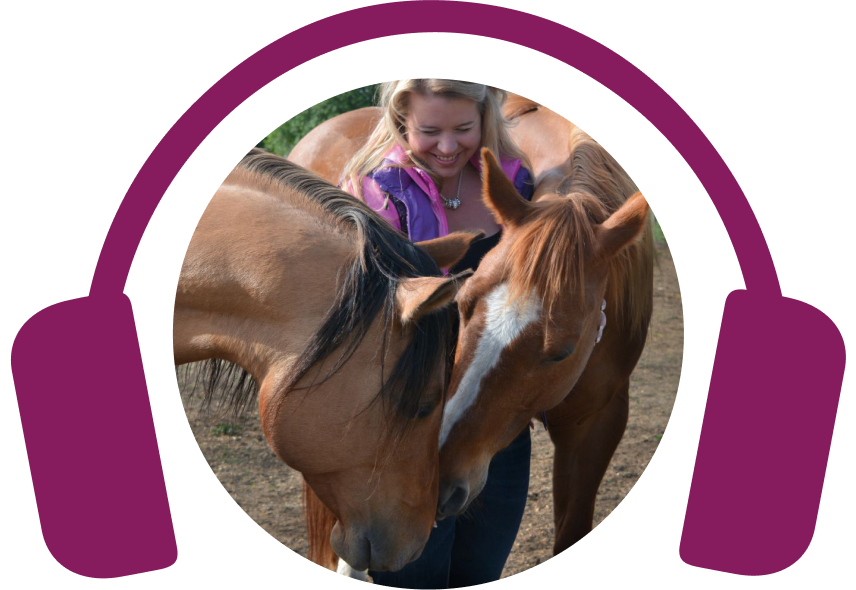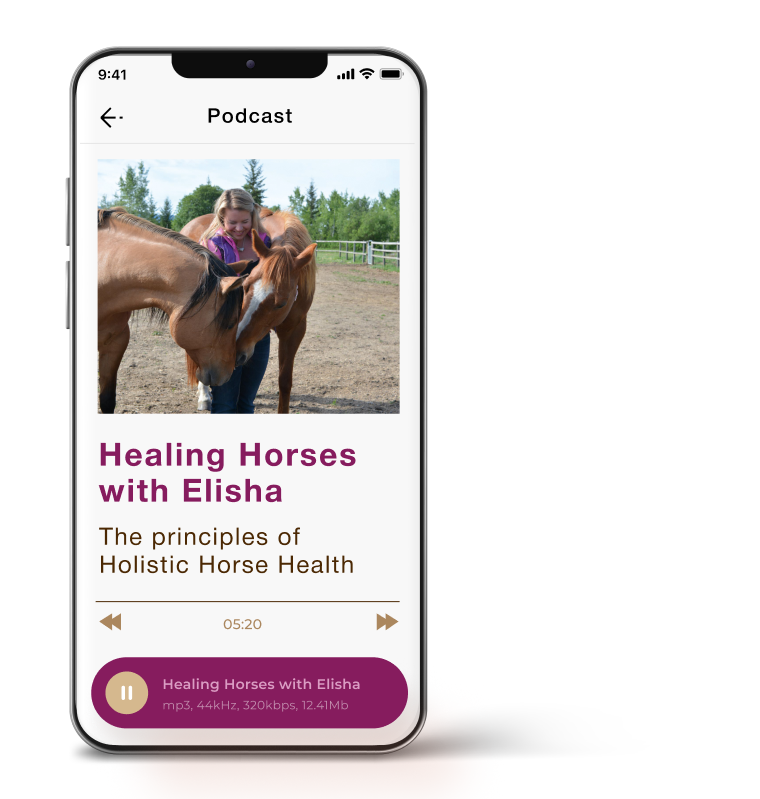Elisha’s Podcast
ELISHA’S PODCAST

Ready to get your horses on the path to better health?
This podcast was created to do just that.
Tune in to get new insights, perspectives, horse health tips, and real-life horse healing stories.
Take what you learn and apply it to your horse TODAY.

One Conversation at a time
From learning what to feed your horse and how to use nutrition effectively, to practicing prevention and approaching specific health challenges naturally, to just bringing your horse more joy and better health…
I’ve got you covered!

Check out my recent episodes
As we move from summer to fall, and temperatures at night start to cool, subtle changes begin to occur in our horses. Shorter days trigger powerful hormonal shifts, often before we even notice. Those shifts play an essential role in the health of our horses- especially those with metabolic conditions. Hormone Shifts and Metabolism Seasonal hormone shifts influence how horses process sugar, maintain muscle, and manage inflammation. In fall, ACTH levels naturally rise, increasing cortisol to drive fat storage and coat growth in preparation for winter. When those hormones remain elevated for too long, however, problems like delayed shedding, thick coats, sweating, muscle loss, inflammation, and a higher risk of laminitis may emerge. Fall as a High-Risk Season Far more horses tend to experience metabolic flare-ups in the fall as it brings a dangerous mix of hormonal shifts, fat storage, and higher pasture sugar levels, all of which raise the risk for equine metabolic syndrome and PPID. As horses naturally conserve energy and build fat reserves before winter, insulin resistance also tends to worsen. Testing and Diagnosis A single test showing high ACTH in fall is not enough to diagnose PPID. As ACTH naturally rises seasonally, it is essential to use multiple test results, and get a complete health profile before deciding on lifelong medication. Insulin, Inflammation, and Weight Insulin is fundamentally a fat-storage hormone. If it is high, horses cannot lose weight. Chronic inflammation from laminitis or hoof pathologies drives insulin even higher, and elevated cortisol keeps blood sugar high, locking horses into a state of fat storage. That combination often causes gain weight and soreness in the fall. Diet and Forage Management Careful forage management is the foundation of supporting metabolic horses. Prioritize low-sugar hay and limit access to rich pasture, especially during high-risk seasons, like fall. Slow feeders, soaking hay, and controlled turnout can all help regulate sugar intake. Consistency in diet not only stabilizes insulin and energy levels but also reduces the risk of flare-ups. Lifestyle and Stress Stress management is as important as diet. Horses need freedom to move, regular forage, and companionship to regulate their cortisol levels and maintain metabolic balance. Stalled or isolated horses, or horses with long gaps between feedings suffer higher stress levels, which compounds hormone problems, and no supplement can overcome the damage caused by chronic stress and inappropriate living conditions. Long-Term Management Consistency is essential. Progress may seem slow at times, but steady attention to low-sugar forage, regular exercise, and stress reduction leads to lasting improvements. Expect seasonal setbacks, but they will be temporary. Over time, consistent care helps horses rebuild their health and resilience. Hormonal Considerations in Mares Mares can be susceptible to seasonal hormonal shifts. Changes in daylight and hormone levels often affect their cycles, behavior, and comfort. For mares with metabolic issues, those fluctuations may add another layer of stress, making careful monitoring and consistent management even more essential. Do you know what exactly is in your horse's supplements, and what they're actually doing for their health? Keeping your horse's diet and supplement program clean is one of the most beneficial things you can do for them. There is nothing that turns a horse's health around faster than cleaning up their diet and supporting their health from the inside out. The good news is I'm going live on Saturday, December 6, 2025, at 10 am Mountain Standard Time, and I invite you to join me for my first-ever two-hour workshop called Detox Done Right: How To Reduce Your Horse's Toxic Load and Upgrade Their Health. For just $127 Canadian, you will get my hands on my label-reading playbook and my clean feed roadmap- and we will finish with a 30-minute Q&A to help turn your supplement confusion into clarity. If you care about your horse's health and want real, practical steps that lead to results, then this workshop is just for you! Save your seat by clicking on the link in the show notes, or head over to my website. No need to worry if you register and miss it because I will have a recording waiting for you, whenever you are ready- but I do hope to see you all there, live! Links and resources: Connect with Elisha Edwards on her website Join my email list to be notified about new podcast releases and upcoming webinars. Free Webinar Masterclass: Four Steps to Solving Equine Metabolic Syndrome Naturally Register for my self-paced course, Resolving Equine Metabolic Syndrome Naturally. This week, we are diving into skin problems with horses. Skin problems are hard to ignore. They are right in your face, so they grab your attention instantly. Types of Skin Problems in Horses Skin issues range from dry, flaky skin to severe allergic reactions. Horses may suffer from hives, sweet itch, infections like rain rot or mud fever, and chronic itchy skin. These conditions may appear as sudden, alarming outbreaks or develop into persistent, long-term struggles. Why Skin Problems Demand Attention Unlike hidden health issues, skin problems are visible and alarming, often pushing owners to act quickly. Acute flare-ups can appear to be emergencies, and chronic flare-ups may frustrate owners when topical treatments and medications only provide temporary relief. Beyond the Surface The skin is an organ and part of the immune system. When reactions occur externally, it is a sign of deeper imbalances, such as inflammation, immune dysfunction, or a toxin overload that can also affect internal systems. Digestive Problems Digestive problems often correlate with skin flare-ups. Ulcers, leaky gut, and poor liver function can raise histamine levels, leading to hives, itching, and chronic skin irritation. When the liver and gut cannot properly eliminate toxins, issues frequently surface in the skin. The Role of Histamines Histamine release is a natural immune response that can cause symptoms like swelling, itching, and hives. Horses with gut issues often produce excess histamine, making them more prone to skin outbreaks. Treating your horse only with antihistamines can suppress symptoms, but that does not solve the root cause. Diet and Allergens Some feeds can trigger skin reactions. Allergies or intolerances (such as to alfalfa) may take years to appear as acute symptoms. Long-term toxic buildup from feed, medication, or supplements can overload detox pathways and weaken skin health. Liver Health The liver plays a central role in detoxification. Over time, medications, poor nutrition, or stress can overwhelm the liver, leading to chronic skin problems. Supporting liver health is the key to sustainable recovery. Triggers Hormone imbalances and stress can affect skin health. Stress-related cortisol and adrenaline spikes increase histamine production, sometimes also triggering ulcers and hives. Managing stress is critical for restoring balance. Long-Term Solutions Quick fixes rarely last. Holistic management focuses on supporting digestion, detox pathways, nutrient balance, and emotional well-being. Owners may need to experiment and make gradual adjustments to find lasting solutions. Key Takeaways Skin health reflects whole-body health. A methodical approach that addresses gut health, liver function, diet, hormones, and stress will lead to lasting improvements, whereas symptom-only treatments will keep horses stuck in recurring cycles. Do you know what exactly is in your horse's supplements, and what they're actually doing for their health? Keeping your horse's diet and supplement program clean is one of the most beneficial things you can do for them. There is nothing that turns a horse's health around faster than cleaning up their diet and supporting their health from the inside out. The good news is I'm going live on Saturday, December 6, 2025, at 10 am Mountain Standard Time, and I invite you to join me for my first-ever two-hour workshop called Detox Done Right: How To Reduce Your Horse's Toxic Load and Upgrade Their Health. For just $127 Canadian, you will get my hands on my label-reading playbook and my clean feed roadmap- and we will finish with a 30-minute Q&A to help turn your supplement confusion into clarity. If you care about your horse's health and want real, practical steps that lead to results, then this workshop is just for you! Save your seat by clicking on the link in the show notes, or head over to my website. No need to worry if you register and miss it because I will have a recording waiting for you, whenever you are ready- but I do hope to see you all there, live! Links and resources: Connect with Elisha Edwards on her website Join my email list to be notified about new podcast releases and upcoming webinars. Free Webinar Masterclass: Four Steps to Solving Equine Metabolic Syndrome Naturally Register for my self-paced course, Resolving Equine Metabolic Syndrome Naturally. The thyroid gland plays a crucial role in the metabolic health and overall vitality of horses, yet it is often overlooked or treated only when serious problems arise. Understanding the role of the thyroid gland and the factors that support or hinder it is the key to long-term equine wellness. Remember that supporting your horse’s health holistically always begins with their diet, lifestyle, and stress reduction. Recognizing Thyroid Imbalance Changes in the coat are often the first visible sign of thyroid imbalance. Horses may develop coarse or dry hair, experience hair loss, shed slowly, or grow curly hair. Those changes are all tied to the thyroid and could overlap with pituitary dysfunction. Metabolism and Temperature Regulation Thyroid health strongly influences weight and temperature regulation. Horses may gain weight despite appropriate feed and exercise, or show cold intolerance by shivering when others remain comfortable. Those signs reflect compromised heat production and metabolic function. Hormones and Reproductive Health Hormones are interconnected, so a thyroid imbalance could also affect the cycling and overall reproductive health of mares. Disruption in one hormone system influences others, highlighting the importance of a holistic approach. Behavior and Energy Levels Thyroid imbalance could manifest as depression, fatigue, or anxiety. Horses may withdraw from herd interaction, appear less playful, or become unexpectedly reactive despite consistent training. Physiological health can drive behavioral changes that horse owners should never overlook. Muscle Health and Mineral Balance Muscle weakness is another possible sign of thyroid imbalance. Selenium deficiency can also present similarly, highlighting the importance of evaluating mineral balance in addition to glandular health. Minerals often influence multiple systems simultaneously. Closing Thoughts Thyroid function is complex because it interacts with the pituitary gland, reproductive hormones, metabolism, and mineral balance. Paying attention to any changes occurring in the hair, coat, weight, temperature tolerance, behavior, and muscle strength can provide practical clues to possible metabolic imbalance. When those signs are present, it is essential to seek the right help to explore whether thyroid health may be a contributing factor. Do you know what exactly is in your horse's supplements, and what they're actually doing for their health? Keeping your horse's diet and supplement program clean is one of the most beneficial things you can do for them. There is nothing that turns a horse's health around faster than cleaning up their diet and supporting their health from the inside out. The good news is I'm going live on Saturday, December 6, 2025, at 10 am Mountain Standard Time, and I invite you to join me for my first-ever two-hour workshop called Detox Done Right: How To Reduce Your Horse's Toxic Load and Upgrade Their Health. For just $127 Canadian, you will get my hands on my label-reading playbook and my clean feed roadmap- and we will finish with a 30-minute Q&A to help turn your supplement confusion into clarity. If you care about your horse's health and want real, practical steps that lead to results, then this workshop is just for you! Save your seat by clicking on the link in the show notes, or head over to my website. No need to worry if you register and miss it because I will have a recording waiting for you, whenever you are ready- but I do hope to see you all there, live! Links and resources: Connect with Elisha Edwards on her website Join my email list to be notified about new podcast releases and upcoming webinars. Free Webinar Masterclass: Four Steps to Solving Equine Metabolic Syndrome Naturally Register for my self-paced course, Resolving Equine Metabolic Syndrome Naturally.
Meet your host
Hi there, I’m Elisha Edwards

Meet your host
Hi there, I’m Elisha Edwards
I have helped guide thousands of horses back to good health over the years from a variety of different health challenges. And through my courses, webinars, and speaking engagements I educate and empower horse owner’s from around the world to take charge of their horse’s health using the holistic model of health care.
So I know first-hand how difficult and overwhelming it can be to navigate all the different opinions and conflicting information that you come across especially when your horse is faced with a health problem. In many cases, the journey is just as hard on the owners as it is on the horses.
I started Healing Horses with Elisha to guide you, support you, and encourage you through the process of prevention and recovery so you feel good about the decisions you’re making for them.
Here’s what I believe
I have seen countless horses with seemingly impossible health conditions that have been resolved so easily with the right combination of diet, nutrition, and natural remedies. In many cases, it is not the health conditions that prevents the horse from recovering, it is the lack of education, resources, and options that are available.
If the insight and information you gain from this podcast gives you some newfound hope or inspires you to take
a new approach then it has served it’s purpose.
Thank you for giving me the opportunity to help you improve your horse’s health.
Keep listening and learning. Your horse is worth it.
Listen Now
Tune in wherever you listen to your podcasts and follow me so you never miss an episode. I release a new one every Tuesday!

Leave a Review
Reviews help me reach more horses and also help me deliver more relevant content to you!

What my Listeners are saying
“Every time I think there is no way to top what you do – you elevate us to yet another level. I wish I had a fraction of your communication skills. You’re amazing and I am so grateful to be apart of the magic you are creating for horses and their humans.”
Tracey
“Your podcasts are fantastic! I get so excited to listen to the next one. I have 6 geriatric horses and your podcast has really opened my mind to new possibilities in their health and given me the strength to help them through hiccups in their well-being the past few months. I have a nursing education and you explain pathology better than my university professors.”
Sharon
“I can’t thank you enough for the Mindset Tips podcast. I really needed this reminder. It was just what I needed to hear to today.”



